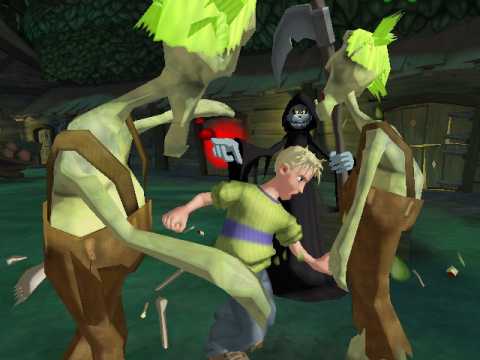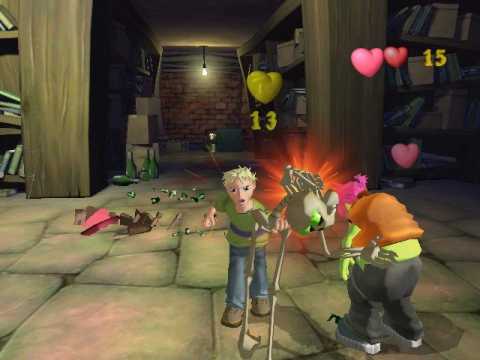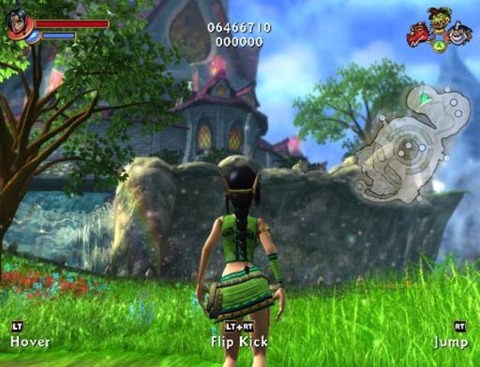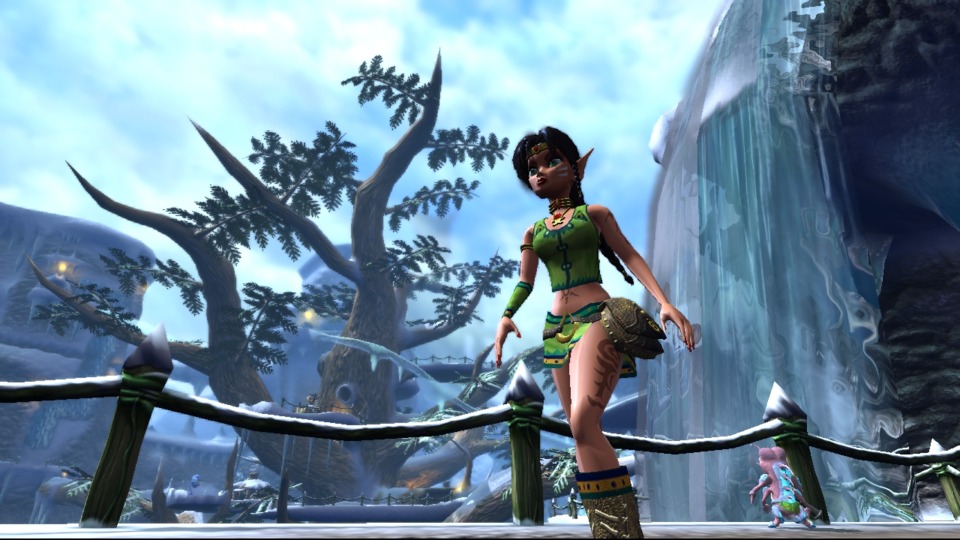RARE REPLAY RELAY, PART 4: Boxed In
By jeremyf 0 Comments

We have officially crossed the 20-year anniversary of Microsoft’s purchase of Rare for 375 million dollars. If you count Ultimate Play the Game as the start of the company, Rare has now been under Xbox’s green umbrella for as long as it hasn’t. Despite that, the quantity of games shipped in the past two decades is tiny compared to the early years. General sentiment has also dictated, almost from day one, that the quality of these games dropped off a cliff. I wasn’t willing to take that attitude at face value anymore, so I entered this latter half of Rare’s history with an open mind. Before I get to these subjective judgments, I think I’ve gleaned enough understanding to theorize why Rare’s design mentality didn’t translate easily to the new paradigm.
Notoriously, Rare’s games in the glory days often underwent massive changes before hitting shelves. Project Dream, an isometric SNES title about pirates, underwent the Ship of Theseus and came out the other side as Banjo-Kazooie. Conker was infamously pivoted from a typical cute platformer into a raunchy parody of one. These characters were front and center in that announcement video we looked at earlier, indicating that this process could get results for popular, desirable titles. It is not, however, one that scales well with technological advancements. Entering the sixth console generation, everything needed to be bigger, prettier, and more intricate. And with the growing pains of early 3D gaming largely finished, expectations were a lot harder to meet.
Massive shifts during development would be much riskier at this point, yet circumstances forced it to happen repeatedly. The sprawling would-be N64 game Dinosaur Planet was legendarily mandated - by Mario’s father himself - to be retrofitted into the Star Fox universe. Rare’s first and last release on the Nintendo GameCube has its fans, but as someone who still enjoys Star Fox 64 regularly, I hope I never have cause to play it. Nearly simultaneously with Star Fox Adventures’s launch, the ink was dry on the Xbox deal. Canceled: Banjo-Threeie, Donkey Kong Racing, and more, creating some of the most tantalizing entries in the company’s long list of what-ifs. Moved from GameCube to Xbox: The next three games we’re talking about… only one of which would actually make the 2001 machine its final resting place. The others were moved yet again to the Xbox’s HD follow-up – but let’s not get ahead of ourselves. Discounting the Conker remake, the only new game Rare would ship on the Xbox would not draw from the announcement video. This was a totally new franchise – one that would barely rise before falling back into the grave.
GRABBED BY THE GHOULIES (RAAAH, RAAAH)

Whatever I’m about to say, that theme song that plays on the title screen is catchy. Anyway, Grabbed by the Ghoulies is more emblematic of past game design trends than of an exciting new generation. At its core, it is a beat ‘em up about a young couple trapped in a haunted mansion. We’ve already done the part where I lambast Battletoads for playing scattershot with its genre(s) and ultimately underdelivering for me. Well, Ghoulies has the opposite problem. It really is nothing more than a series of rooms with a bunch of enemies to kill. For all its attempts at variety, there is a very limited set of interactions here. At the genre’s peak, shallow mechanics weren’t a big deal because, ideally, beat ‘em ups could be finished in less than an hour. Ghoulies is significantly longer than that – around four or five hours – which is still significantly less than a typical player at the time would want out of their purchase. The game does not advance its ideas meaningfully enough to fill its length.
The primary element to set Ghoulies apart is its control scheme. It plays almost like a twinstick shooter, wherein the direction of the right stick orients Cooper and his direction of attack. You can master it, as I did by the end of my journey, but I always felt a small amount of impreciseness even then. It never felt natural. In the wrong situations, you can quickly get stun-locked and demolished by enemies. I assume the designers took too long settling on the fighting and quickly had to fill a whole game with it. It would explain why the best they could come up with for variation is a truckload of modifiers. Each room has a condition to fulfill to open the way forward. You may need to kill X number of Ghoulies, kill one type but not another, protect objects, attack only using weapons… there is no shortage of these, but they always feel like an inconvenient stipulation instead of a fun challenge. Failing these objectives does not result in an immediate game over, though. Instead, it summons the grim reaper, who instantly kills anything he touches – fellow enemies included. I did enjoy the risk/reward element introduced with him, especially when you decide to take your chances instead of playing “properly.” Sometimes Cooper will be given semipermanent weapons for a few rooms, which feel poor and limiting. Beyond that, each room also alters your maximum health. The whole thing reeks of a transparent attempt to spice up one-note gameplay. It all comes off as arbitrary.

To veer into the positive, the visual style is generally well-aged. The generational leap was clearly freeing for artists who were already doing a lot with a little. Cel-shading brings out the personality even more, and in 2022, it’s still readable and evocative. Characters can be hit-or-miss, though. Cooper is a flat nothing of a design. The only traits I can pick up are that he gets scared a lot and probably roots for an awful soccer club. Friendly NPCs aren’t inspiring, either, fulfilling well-worn archetypes without much invention. Ghoulies could be ugly or not depending on your taste. I like the look of the shambling Igor type, but the imps are Jinjos under a different name, and the coffin-bound vampires are disturbing in a not-fun way. Even the best designs are undermined by the incessant vocalizations from everything on screen. It was cute in Bano-Kazooie, but it’s a bridge too far now. Don’t ask me to pin down the difference.

As far as achievements go, there aren’t so many hoops to jump through. Really, it’s just one massive hoop. The primary thing to watch for as you hop along the manor is each room’s bonus book. I missed a handful, but you can jump back to individual sections and make up for your errors. I was not expecting a 2003 game to be so granular with its chapter select, but it was much appreciated. Filling out the set of books unlocks additional challenges to complete. Doing so to gold standard is not that hard, but the extra final challenge that acts as the reward certainly is. It’s another run through the entire game, this time as Cooper’s girlfriend Amber, with a permanent maximum health of just 5. This makes certain rooms nightmares, especially the boss fight against… Amber. Always weird when that kind of thing happens. Whenever possible, the preferred course of action is to summon the reaper and kite him the best you can. I wasn’t happy that a single achievement once again stretched out my time with a game. On the bright side, I can easily claim myself to be in the top 2% of Grabbed by the Ghoulies players on the planet. Yay? If there’s one thing I wish Ghoulies had taken from classic beat ‘em ups, it’s co-op play. That would only make things harder on myself, I’m sure, but even the most mediocre titles are bolstered with a buddy. While beat ‘em ups were no longer prestigious in the early 2000s, they were still prominent. They made up the loads and loads of licensed tie-in games for kids. Pretty dubious company, and the fact that Grabbed by the Ghoulies was never listed on the Xbox store for individual purchase tells me that everyone involved is also ready to move on. As the kids say… it’s thoroughly “mid.”
Just as we were getting to know the Xbox, it’s time to say goodbye. I did a double take the first time I read that two Rare games launched with the Xbox 360 in 2005. That would be like Ratchet and Clank releasing alongside Miles Morales for the PlayStation 5. This tells me that despite a shaky first few years, Microsoft still had a lot of faith in Rare to sell their brand. This would be a double-edged sword for Rare, though. The bonus features for both these games tell of increased scope and pressure, ending with a sentiment that any release after moving consoles twice is miraculous. Despite the developers’ resolve, neither Kameo: Elements of Power nor Perfect Dark Zero seem remembered that fondly, if at all. This is especially true for Kameo, a game I consistently forgot about while working through this project. Perfect Dark is at least a sequel to a popular N64 game. Kameo had the misfortune of releasing as an ambitious new franchise, only to be overshadowed by a game from the same studio. Maybe that’s why we don’t see this strategy so much anymore. Not to pile on, but I do have a lot more to say about Perfect Dark than Kameo – so much so that the former earned a blog entry all to itself. Still, there is more than enough to dissect with what could have been Xbox’s Zelda under different circumstances.

In this mystical land, there is a raging war between the ugly trolls and the pure elves. That’s elves, Xbox gamer bros. Ignore the wings, these aren’t wimpy fairies, they’re cool, badass elves! Okay, whatever you say. As the chosen princess, Kameo inherited the ability to transform into a host of elemental warriors. After an opening level in media res, she loses her powers, and subsequently must reunite with each warrior to confront her turncoat sister and bring about peace. It’s a frankly barebones plot, with additional details of backstory received throughout adding little worth retaining. Rare’s storylines have always played a supporting role at most, and if there was any place for that to change, it would be in their big fantasy tale. But perhaps it’s better that they didn’t bite off more than they could chew for that specific aspect.
Kameo’s personality may be on the undeveloped side, but fluttering about with her glide move feels nice and airy. That said, she’s not terribly useful beyond that. Her only attack is a low-damage flip kick that’s nonetheless always accompanied by a dramatic slow-down effect. Much of the time, you will instead embody one of the elemental warriors. The three warriors in the opening level are a nice cross-section of how the mechanic works. The Yeti creature can climb ice walls and throw icicles at far-off foes or switches. The plant can burrow under gates and spring up to uppercut enemies. The armadillo can imitate a certain hedgehog’s spin dash to zoom up ramps and act as an improvised pool ball. You can have three of the 10 warriors equipped at once and swap between them with the face buttons. The rest can be reassigned from the menu. Yeah, it’s lifted straight from Zelda. Longtime Rare fans are surely overjoyed to skip the soul-draining treks to a tag barrel to change characters. Even still, I got a little impatient with how often I needed to pause. Some warriors will spend a lot of time on standby, while others will be practically forgotten.
There is one trait that every warrior shares, though: being unbearably ugly. I don’t know what happened with these designs. They look like rejected Sewer Sharks bad guys. Unappealing colors, strange proportions, and even more amateur vocalizations kibosh any sense of excitement for these characters. They even draw attention to it by presenting the elementals in a “baby” form, then subjecting you to a speed-puberty sequence where limbs contort and eyes go bloodshot. Fortunately, you will spend most of the time looking at the creatures’ backs, but that only lowers your guard for the next time you see them in full. I would say that Kameo herself, with a redesigned outfit compared to early promotional material, is the only appealing design in the game. The other NPCs are just as off. Fellow fairies have totally different body styles, and other races are hard to even parse. The juxtaposition is eerie.

To give the graphics some credit, when they are focused on smaller areas, the art direction is strong and shows off some of the power you would hope for from a console launch game. The loop is exploring these village spaces until you recover an elemental warrior that will lead you into a dungeon. Compared to a Zelda dungeon, the puzzles are light, in the realm of using a dragon’s fire breath to light torches. The focus is more on linear combat encounters and set pieces. You will switch forms often to traverse, but combat will rely on whatever warrior has the best damage output, making fights largely one-note. These dungeons serve another purpose, which we’ll talk about later. Finally, there are sections set in the Hyrule Field equivalent, bearing the most obvious scars of a troubled development cycle. A massive battle with thousands of creatures is endlessly transpiring, but on your first visit, you are literally told to ignore it all and rush to the destination. Only some brief defense-style moments ever make use of this setup, one that must have been a massive technological hurdle.
The game continues shifting between these modes for a while, concluding with a rather easy boss fight and a tease for a sequel that would never leave pre-production. The images for a grimmer Kameo 2 in Rare Replay’s bonus features are interesting nonetheless. Accumulating the needed 750 Gamerscore here is a tale of highs and lows. Merely finishing the story will award 600! This will be easy, right? Not necessarily, depending on your skill. Kameo’s dungeons are unusual in that they can be replayed in score attack for higher ratings. That is where the bulk of the remaining achievements are tied up. During the campaign itself, you would be forgiven for forgetting a scoring system exists at all. It’s always lurking at the top of the screen, but it serves no purpose whatsoever. The only explanations of the system’s intricacies are hidden on the side of a room you don’t even need to enter. Basically, you iterate your combo by killing enemies and get penalized when taking damage. Build the number high enough and land attacks fast enough, and you enter a bullet time mode where high-point value enemies spawn. Your only real path to an A rank is maximizing the number of baddies killed in this mode, one you would only likely activate by accident naturally.

Based on my calculus, I would need at least one A rank no matter what. I decided to focus on the opening level. It would have both the easiest enemies and the fewest moving parts to stress over. I ran through the 10-minute sequence a few more times, but while I raised my F to a low C, it was clear that I needed better strategies, and I really should have just looked at a video to begin with. There’s a part near the end where, minutes after you’ve already cleared an encounter of trolls, a few dozen more jump out. This is the ideal spot for point grinding, and it’s not a scenario you could find unless you were specifically looking for it. Even with the new knowledge, it was not smooth sailing. It took a few runs to even work up the skill for staying in bullet time with the armadillo. There’s also a part where you’re in a narrow corridor with a fire troll – getting set on fire eviscerates your combo and effectively kills the run. I was very sick of the level by the time I finally secured the A rank, but ultimately thankful I didn’t need to chase any others.
Then, I had to clear every dungeon again in Kameo’s stapled-on co-op quest. Yet again, Imaginary Player 2 was the best ally I could ask for. I was not enjoying the repeated playthroughs, though. I got disconnected from the Xbox network at some point and had to do one stage again for the achievement to pop. Lastly, I returned to the postgame to track down every collectible in the land – a smaller number than I had feared. Just in the course of playing, I had acquired something like 75% of them. But in doing so, I had unknowingly shot myself in the foot. The game doesn’t keep track of which items were found where, and I certainly wasn’t either. That meant I had no idea what I still needed when I pulled up a guide. I had wanted a break from playing with one eye on a walkthrough, but I really should have been more organized here. I ended up visiting every location where I might have missed something, ultimately doing a lot of unnecessary backtracking and growing a stony hatred for the snow village’s nonsensical layout. Process of elimination ultimately got me there. It was an anticlimactic ending to this leg of the journey, but hey, a win’s a win.

Kameo is a unique fusion of sixth- and seventh- generation design. It makes use of the 360’s added power, but the moment-to-moment actions are very in line with earlier trends. To play it now is to experience an end of an era before the HD standard would enforce a lower-risk, and typically less experimental, method of development. Were I not recording the major moments of this journey, I’m sure Kameo would have faded out of my memory like so many others. But beneath its compromised final presentation, a good idea rests at the core. Next, we’re looking at a game that launched on the very same day but earned a notoriety that endured a fair bit longer.
